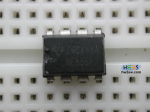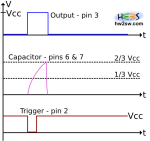
This is the last circuit proposed as working for an astable multi-vibrator.
It's now time to understand why this can or not correctly operate and if some issues are still present.
Due to the presence of R and C for each branch we're sure that the timing feature is somehow guaranteed; but how exactly is a matter we're going to see.
As already said at the switch-on one of bjts surely goes in saturation before the other which is so forced to go to interdiction.
We added the capacitors not only to make a timer as proposed but to alternates the states for the outputs too.
Let's suppose bjt2 wins the lottery and goes to saturation: its collector drops form Vcc to nearly 0.2V.
Due to the transitory nature of this falling signal, the capacitor won't block it at first instance so that it (the drop of ~Vcc) will be replicated at its other top which connects directly to base1, the new value of which becomes:
newVb1 = Vb1 - ~Vcc


